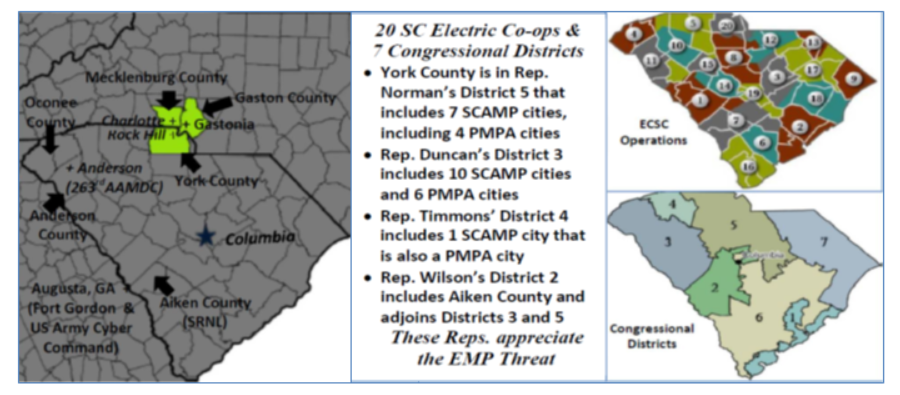Lake Wylie, on the Catawba River that flows from North to South Carolina, hosts three Duke Energy electric power plants and Transmission Lines to pass electricity to York County Distribution Lines operated primarily by Rock Hill Utility and York County Co-operative companies to provide it to York County citizens. The Lake Wylie Pilot Study promises to protect local citizens and be followed by others in South and North Carolina and beyond.
The nation’s Power Generation Plants (shown in Red below) that deliver high voltage electricity via “Generator Step-Up (GSU) Transformers” to nominally above 100 kilovolts (kv) to be carried over long distances by high voltage Transmission lines (Blue) to the Distribution Grid—consisting of key “Substations (Green),” where “Step-Down Transformers” deliver electricity to Distribution lines (Green) to customers (Black), citizens and all their critical services. The “Bulk Power grid” (Red and Blue) is composed of the Power Generation Plants and the Transmission lines. The Distribution Grid (Green and Black) composes about 90-percent of the nation’s overall grid and about 70-percent of total investment in the combined Transmission and Distribution lines. The Distribution Grid is the primary focus of the Lake Wylie Pilot Study, and the associated Bulk Power Grid will be considered in the future.
Figure 1—Representative Electric Grid Infrastructure Components
As explained previously (Click here and here for recent extensive discussions.), the descriptors “Transmission” and “Distribution” both are pathways for delivering electricity, but “Distribution” lines actually deliver electricity to most customers — to private citizens and commercial, government, and others that provide essential support to all in America, including to hospitals, water-wastewater management and delivery, other utilities, emergency management, essential communications, businesses, people, industry, transportation, etc.
The York County, SC Bulk Power Grid (consisting of the Wylie Hydroelectric Power Plant and Catawba Nuclear Power Plant and associated Transmission Lines) is owned and operated by Duke Energy. The Distribution Grid provides essential electricity to support most if not all these important functions in York County and is owned and operated mostly by Rock Hill Utility and York Co-op companies. The Lake Wylie Pilot Study has from the outset been a cooperative effort of these three companies and their engineers, who are totally responsible for providing electricity to all York County citizens.
In South Carolina, we have a microcosm of the national electric power grid in that there are two main “Bulk Power Grid” sources of electricity — Duke Energy and Dominion Energy companies — and about 40 Municipal Utility and Electric Cooperative (Co-op) companies that, in addition to Duke Energy and Dominion Energy, manage the SC Distribution Grid. Lessons-learned in effectively integrating these complexities from the Lake Wylie Pilot Study are of broad interest across South Carolina, and ultimately throughout the nation — as we collectively seek to protect the national grid against the full spectrum of threats, particularly existential natural and manmade electromagnetic pulse (EMP) threats.
The left figure of the above illustration illustrates a“quilt” of tens of counties across North and South Carolina and Georgia. In green are the three counties most closely involved in our near-term Lake Wylie Pilot Study Plans. Mecklenburg and Gaston Counties in North Carolina and York County in South Carolina surround Duke Energy’s corporate headquarters in Charlotte, NC — the center of the 22nd most populous U.S. metropolitan area. These three counties are served by a Distribution Grid that receives its electricity from Duke’s Bulk Power Grid.
We agreed with Duke engineers to initially focus on York County, home of two of its power generation plants — the Wylie Hydroelectric Plant and the Catawba Nuclear Power Plant. I plan to extend the lessons-learned to the two neighboring NC counties and to four indicated SC counties, with a top priority associated with key related national security missions.
We focused early on Rock Hill, a major Charlotte suburb and the fourth largest city in South Carolina — and served by the Rock Hill Utility Company, a member of the PMPA. The rest of York County is served by the York County Co-operative (co-op) company.
Rock Hill’s Assistant City Manager, a Clemson engineer, is also the President of the PMPA, which includes 10 cities of the Piedmont region of South Carolina, and Rock Hill’s Chief Engineer is Vice President of the South Carolina Association of Municipal Power (SCAMP) that includes the other 10 Municipal Power Companies of South Carolina — 20 in total as illustrated in the right hand side of the above illustration. Notably, the president of the York County co-op, another Clemson graduate, is a member of the Electric Cooperatives of South Carolina (ESSC) — that represents 20 SC co-ops.
These two individuals provided great support to our efforts to assess the viability of York County’s Distribution Grid, especially in confronting the existential electromagnetic pulse (EMP) threat, which I have discussed extensively over the past five or more years.
In particular, they opened their critical infrastructure for a careful examination by Dr. George Baker’s assessment and estimates of the cost of hardening their critical Distribution Grid infrastructure. (Dr. Baker is one of the nation’s foremost authorities for employing such hardening methods, having used them to protect our most important military systems against direct EMP attack.)
His bottom-line estimate for employing the same hardening methods used to protect our most important military systems to protect York County’s critical Distribution Grid infrastructure was less than $100 per citizen of York County. This investment, which is less than what a family pays monthly for its health insurance, would protect the most important civil activities of York County — e.g., its hospital and top priority support, such as water-wastewater, emergency management, communications to state and national authorities, etc.
Moreover, York County’s PMPA/SCAMP/ESSC contacts across South Carolina will enable follow-on efforts to export the lessons learned throughout the 46 counties of South Carolina. Getting on with implementing that gameplan should be a “no-brainer” for the “powers that be” — if only they can figure out how to provide the needed funds. A challenge for their elected leaders, you think?
The center section of the above chart identifies the Congressional Representatives of citizens of the Districts that I hope will lead this propagation of lessons learned and needed funding to protect the Distribution Grid of South Carolina. They and their staffs are informed about the EMP threat and our efforts, and I expect them to be supportive. Moreover, our efforts have also set the stage for extending our lessons-learned into North Carolina and beyond.
In summary, our gameplan for next steps includes considering how best to achieve the needed funding for protecting the Distribution Grid involves the expected full cooperation of the managers and engineers of Rock Hill Utility, York Electric Co-op and Duke Energy, to complete a meaningful “bottom-up” program to assure the viability of the three Duke Energy power plants on Lake Wylie — and of course associated key Transmission and Distribution infrastructure connecting those power plants to their customers.
Duke Energy is funding related research at several universities and in cooperation with other energy companies. While that research is primarily focused on the cyber threat, EMP concerns will no doubt also receive attention. Notably, Duke is investing significantly to modernize and protect its power systems over the next 10 years, reportedly $13 billion in North Carolina alone and $25 billion in other states.
We have agreed to share lessons-learned with other counties in the “patchwork” indicated on the left side of the last figure. Our near-term game plan is to:
- Complete our York County effort, including its associated Bulk Power Grid, owned and operated by Duke Energy.
- Proceed in South Carolina to Oconee County — which includes Duke-operated hydroelectric and nuclear power plants) and Anderson County (to include the vital role of the National Guard in commanding the 263rd Army Air and Missile Defense Command (AAMDC). Its commander directly reports to the Commander of Northern Command (NORTHCOM) and has broad responsibilities associated with homeland defense missions.
- Fold in Gaston and Mecklenburg Counties in North Carolina to complete the counties around Lake Wylie and include Duke corporate headquarters.
- Repeat this pattern of activities in Aiken County, which includes the Savannah River National Laboratories (SRNL) that is conducting very important testing of High Voltage Transformers and is a bedroom community to Augusta, GA — home of Army Cyber Command. (This step will involve Dominion Energy that is the second major Bulk Power Grid energy company in South Carolina).
In these initiatives, we understand that we cannot protect everything, so we must place priorities — in both the Bulk Power Grid and the Distribution Grid, so far the focus of the Lake Wylie Pilot Study.
While seeking to support Duke Power efforts to protect the Bulk Power Grid, we have focused on assuring Distribution Grid viability by protecting key life support infrastructure — e.g., hospital and water-wastewater infrastructure and essential communications and transportation/mobility for local and statewide emergency management.
President Trump’s March 26, 2019 Executive Order strongly supports efforts to prepare for EMP effects through targeted approaches that coordinate whole-of-government activities and encourage private-sector engagement.
The Lake Wylie Pilot Study and its potential extensions provides an important immediate “bottom-up” step toward implementing the President’s vision to help protect the American public from the growing existential EMP threat. Moreover, it already has undermined the myth that hardening the electric power grid would be enormously expensive.
The York County study demonstrates quite affordable costs to harden the Distribution Grid to the same standards that we have employed to protect our most important military systems — our strategic nuclear systems and their command, control, communications and intelligence systems.
Our Lake Wylie Pilot Study has not yet completed study of the Bulk Power Grid components directly engaged with the York County Distribution Grid — but that objective should be agreed upon within months, even though reform of cost recovery mechanisms may take longer.
We anticipate these costs will also be quite affordable. But there may be serious issues in getting cost recovery for hardening and maintaining a confidently protected Bulk Power system — to be addressed in the follow-on effort.
These affordable protection measures should be supplemented and augmented with “rigorous independent Red Team” assessment and testing activities to assure that the hardness achieved is maintained and not undermined by deficient maintenance or other legitimate operations. Such important activities should be planned with associated cost estimates as part of the on-going follow-on efforts discussed above.
Executing appropriate hardening and related management operations is complex and can cause frustrating delays. Dealing with the important regulatory world is complex and frustrating. Regulations for the Bulk Power Grid are one matter; for the Distribution Grid is much more complex and varies from state to state. Financial incentives should be developed to assure an improved sustainable status of both the Bulk Power and Distribution Grids.
Recommended Pilot Study next steps can play a “pathfinder” role for understanding and solving the problems of assuring the viability of the SC Distribution Grid supported by the 40 Municipal Utility and Electric Co-op companies throughout South Carolina — and assuring that their operations are properly integrated with the Bulk Power Grid of power plant and Transmission Grid infrastructure serving the State of South Carolina.
The recommended progression of next steps in South Carolina will also help enable and underwrite the protection of nationally important military operations, such as the 263rd AAMDC, which has nationally important missions and directly reports to the Commanders of First Air Force (Tyndall AFB, FL) and First Army (Ft. Sam Houston, TX), as well as the Commander of Northern Command in Colorado Springs, CO.
Other important national security related activities include Shaw AFB in Rep. Norman’s District and Ft. Jackson in Rep. Wilson’s District — as well as Savannah River National Laboratory and its important related activities and the nearby Army Cyber Command Headquarters on Ft. Gordon in Augusta, GA.
As soon as possible, concurrently integrated activities should extend the lessons-learned into North Carolina — first to Gaston County completing the counties bordering Lake Wylie and then to the much more complex Mecklenburg County that includes Charlotte and Duke Energy’s Corporate Headquarters. This will extend the Lake Wylie/York County lessons learned into the nation’s 22nd largest population center.
Bottom Lines.
The layered progression of lesson-learned by our “bottom-up” approach can be repeated and extended by other locations around the nation.
This approach can inform and empower our citizens and their local and state authorities, so they will understand and solve the problems nearest to them — and therefore best dealt with by them.
In doing so, critically important information — learned decades ago as we protected our most important military systems against EMP effects — should be made available to our citizens and their local authorities so they can protect themselves. Judicious funding measures are also required.
Managing these activities is a challenge given the bureaucratic tendency to overclassify and withhold critical information from the private sector that is closest to our national grid and most responsible for its maintenance and operations.
This challenge hopefully will be met as the White House National Security Council oversees the President’s March 26, 2019 Executive Order with assuring a “whole of government” response to the existential EMP threat.
Senator Ron Johnson, as Chairman of the Senate Homeland Security and Natural Resources Committee should review the status of President Trump’s important March 26, 2019 Executive Order. Time’s a’ wastein’!
What can you do?
Join us in praying for our nation, and for a rebirth of the freedom sought, achieved and passed to us by those who came before us.
Help us to spread our message to the grass roots and to encourage all “powers that be” to provide for the common defense as they are sworn to do.
Begin by passing this message to your friends and suggest they visit our webpage www.highfrontier.org, for more information. Also, please encourage your sphere of influence to sign up for our weekly e-newsletter.
Encourage them to review our past email messages, posted on www.highfrontier.org, to learn about many details related to the existential manmade and natural EMP threats and how we can protect America against them. I hope you will help us with our urgently needed efforts, which I will be discussing in future messages.
Click here to make a tax deductible gift. If you prefer to mail a check, Please send it High Frontier, 20 F Street 7th Floor, Washington, DC 20001.
Please click here to read Past Weekly Updates!
Please help High Frontier continue this important and timely work!
Be sure to follow us on our Social Sites!
If you found this letter via our Social Sites, and you would like to subscribe, please click below!







